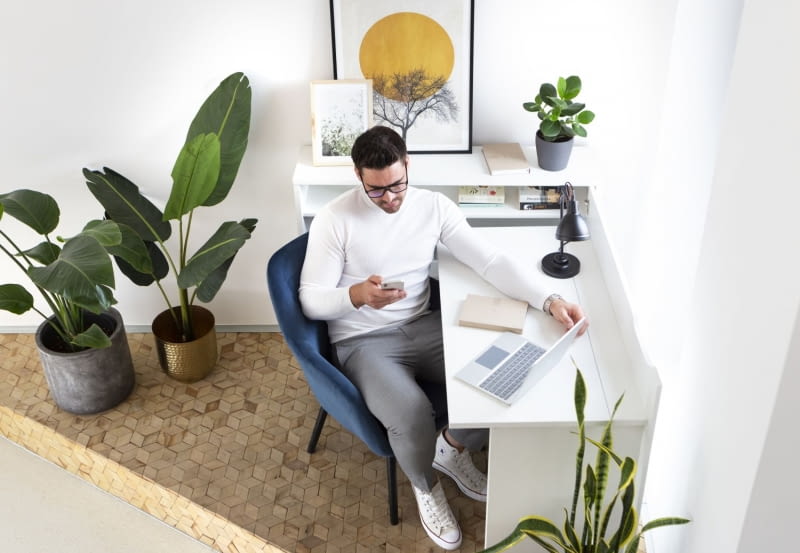
Home office for remote work – how to arrange it?
Today, remote work is not only a convenient solution, but increasingly everyday life. However, for it to be really effective and comfortable, a laptop on your lap and the Internet are not enough. A well-organized, ergonomic and friendly workplace is needed. Learn how to arrange a home office that is functional, aesthetic and conducive to concentration.
A home office is more than just a desk and a chair
For many people, remote work was initially a temporary solution. Over time, however, it turned out to be a permanent model. Along with this came the need to create a professional working environment at home. Regardless of the size or budget of –, it is possible to arrange a space that will promote productivity and at the same time fit well into the arrangement of the apartment.
A home office is not only a place to perform duties – is a space that affects our mood, health and efficiency. Poorly selected furniture, ill-considered colors or inappropriate lighting can discourage work, distract and, over time, even negatively affect health.
Ergonomics – health and comfort in the home office
Long hours spent at the computer are an everyday occurrence of remote work. Therefore, ergonomic workstation equipment is the absolute basis. A suitable desk, a well-fitting armchair, monitor positioning and access to light are elements that actually affect our spine, eyesight and overall well-being.
It is worth ensuring that the
- the desk was the correct height, typically 72–75 cm, and allowed the forearms to be conveniently placed at right angles.
- the office chair was adjustable in multiple planes – backrest, armrests, seat height – and had lumbar support;
- the monitor was at eye level, approximately 60–70 cm away, to avoid tilting the head and squinting.
- the legs had a stable – back if they did not reach the ground, a footrest would be helpful;
- the keyboard and mouse were positioned symmetrically and at the same height, preferably on a separate drawer.
Even in a small space, it is worth taking care of these elements – ergonomic solutions allow you not only to work more effectively, but also to avoid many health problems in the future.
Lighting – productivity ally
Well-chosen light is not only a matter of aesthetics, but above all, efficiency and health. A room that is too dark causes rapid visual fatigue, drowsiness and decreased concentration. In turn, too harsh light can cause headaches and eye irritation.
The ideal home office should include.
- natural light – it is best to place the desk sideways to the window to avoid reflections on the screen and at the same time use daylight;
- general lighting, e.g. ceiling, evenly brightening the entire space;
- desk lamp – with a movable arm and intensity control, placed on the opposite side of the user’s dominant hand so as not to cast a shadow when writing.
Neutral light works best (approx. 4000 K) – closest to daylight, supporting concentration and at the same time gentle on the eyes.
Colors in a home – office that support focus?
The colors of the interior are of great importance for our psyche. What surrounds us can be energizing, calming or… distracting. Therefore, it is worth consciously choosing colors for your home – office not only on the walls, but also in accessories and furniture.
Colors that support work and concentration:
- – green is associated with nature, calms and relaxes, but does not sleep;
- blue – has a cooling effect, supports focus and promotes precise work;
- bright grays and beige – neutral, do not distract, blend well with natural light;
- white – brightens the space, but it is worth breaking it with warm accents so that it is not too sterile.
In turn, the colors to avoid are.
- red and intense orange – can be stimulating, but also aggressive, which does not promote long-term concentration;
- neon lights and bright colors – quickly tire your eyes and can be distracting;
- dark shades, if used in excess, can overwhelm and optically reduce space.
Home office furniture – functionality and style in one
Furniture is the heart of a – home office and determines the comfort of work, organization and aesthetics of the entire place. Regardless of whether you work at a table in the living room or have a separate work room, it is worth investing in several well-thought-out elements.
Good home office furniture should:
- to be ergonomic, that is to say to allow work in a healthy position;
- have sufficient storage space to avoid chaos;
- fit into the interior style of a – home office doesn’t have to look like a corporate space;
- be easy to maintain – choose materials that are durable and resistant to dirt;
- allow for flexibility – mobile containers, height-adjustable desks, modular shelves.
If you do not have a separate work room, it is worth investing in furniture that can be easily closed or folded –, e.g. cabinets with a pull-out top or secretaries. Thanks to this, after work, the space returns to its original function.
Work zone in a small apartment – how to separate it?
Not everyone has the opportunity to arrange a full-fledged office. In many cases, the office must fit in the bedroom, living room or even hall. But even in such conditions, you can separate a functional work corner.
Proven tricks for a home office in a small space:
- using a screen, bookcase or curtain to separate the desk area;
- changing the colour of the wall or using wallpaper only in the workplace;
- setting up the desk in a recess or diagonal to make the most of the available space;
- hanging shelves above the desk for better organization;
- the use of foldable or closed desks that disappear from view after work.
Even the smallest, well-organized space can promote the concentration of –, which is important so that it does not interfere with the living area of the apartment and does not remind you of work after its completion.

